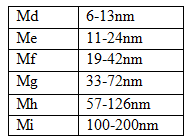Volume 13 issue 4
How to measure the Appearance of the Coating? – Part - II
Mottling
Ashish Zore, Graduate student, Missouri University of Science and Technology
Mottling is an undesirable defect which can occur due to improper coating formulation or variations in the application process. Mottling effect can be described as patches or irregular areas of lightness variations. They are more frequently observed in light metallic coatings. One example for cause of mottling can be the variation of the film thickness of the basecoat which leads to various mottle sizes giving a non-uniform appearance. Sometimes, disorientation of the metallic flakes also result in mottling.
Figure 1. One example for cause of Mottling (a) Proper orientation of flakes (c) Improper orientation of flakes (b) Evenness of the surface (d) Unevenness or waviness of the surface gives partial hiding.
Distance affects the perception of mottling – large mottles are visible from a larger distance while the small one can be seen when close to the surface. This visual evaluation is also affected by illumination conditions and viewing angle.
Figure 2. (a) Measurement principle of BYK cloud-runner, (b) Picture of the instrument – BYK cloud-runner.
To evaluate the mottling, the lightness variation must be measured over a large sample area and under different viewing angle. The cloud-runner device by BYK scans the surface and measures the lightness variations. The coated surface is illuminated by a white light at an angle of 15° to the normal and the lightness is detected at three different viewing angles: 15°, 45°, 60° from the specular reflection. This device can be rolled over the surface for a desired distance and get the lightness variations across the surface. The cloud runner instrument stimulates visual perception of mottling and is dependent on illumination conditions, observing distance and viewing angle. The instrument uses three different viewing angles to stimulate visual evaluation under different observing conditions.
The instrument measures lightness variations over the surface under different detection angles. The measurement signal is divided into six different size ranges using mathematical filter functions. The lightness variations of the surface is rated as a number for each angle and mottling size.
The higher the rating value, more visible is the mottling effect. The rating can be plotted for different mottling size and at different viewing angles (see figure 3). This gives an idea of distribution of different mottle sizes spread out across the surface.

Figure 3. Plot of Rating for different mottle size at different viewing angles.
From the plot above, we can say that the surface has large mottles are more visible at a viewing angle of 15° whereas at 45° & 60° the visibility of the large mottle is lower. As mentioned earlier the visual perception is dependent on the viewing angle.
To solve the mottling issue one can use a better wetting agent, rheological additive or change the application technique like spray gun, distance, etc. This can solve the orientation of the pigment flakes and reduce the unevenness of the surface. One can use the wave scan (used for measuring DOI and Orange peel) to measure the waviness or the unevenness of the surface.
Reference:
- BYK-Gardener, QC solution for coatings and plastics, 2009 Catalog.



